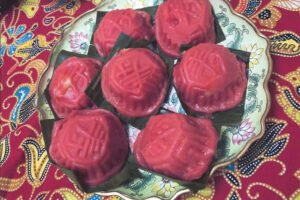LEGEND
Popular legend tells of a turtle that saved two shipwrecked fishermen, one a Malay and the other Chinese. The turtle did this by transforming itself into an island, where the two friends are believed to have contentedly lived for the rest of
their lives.
KUSU
Kusu – in the Chinese Hokkien dialect, ‘ku’ means ‘turtle’ and ‘su’ is ‘island’ – covering about 85,000 square metres, south of mainland Singapore, in the Singapore Strait, is said to resemble the shape of a turtle. A sanctuary for such creatures, plus several large turtle sculptures, add to the peaceful, rustic atmosphere.
A BUSY MONTH
An annual event takes place on Kusu island throughout the ninth month of the lunar calendar, which is from Wednesday 6 October to Thursday 4 November this year. Thousands of people normally visit the island during this period via a 20-minute ferry journey from Marina South Pier; past statistics indicate that about 100,000 visitors travel to Kusu during this time of pilgrimage. At one end of the island stands a Chinese temple and nearby there are three Malay shrines (kramats).
Worshippers at Tua Pek Kong Temple pray for good health and for fertility, that they may be blessed with sons. Hard-boiled hens’ eggs (symbolising new life), painted auspicious red for good luck, as well as flowers, fruit and cooked chicken, are offered to the deities. At the shrines, reached by climbing up a long flight of steps, prayers are also said for good health and for babies to be born to childless couples.
For many people, visits to Kusu also involve picnics, games and swimming. My husband has happy childhood memories of these activities with his mother, many siblings, aunts and several cousins, where the picnic lunch was invariably a large pot of homemade chicken curry eaten with fresh loaves of bread. The happy group totalled about 15 people each year and they hired a boatman who ferried them by bumboat from Clifford Pier to Kusu Island.
LONGEVITY

Turtles may be seen, in many forms, at many Chinese festivals and occasions, valued for their deference to longevity. Ang ku kueh comes instantly to mind. The red (ang), turtle-shape (ku), cake (kueh), made using glutinous rice flour, contains sweet paste fillings of peanuts, red beans or green beans. This auspicious cake is traditionally served at important events such as the ‘full moon’ celebration when a baby is one month old, representing good wishes for a long life for the infant. The individual soft, sweet, chewy, sticky cake is also a mainstay at other happy occasions, like birthdays, graduations, weddings, promotions and similar. To accept an ang ku kueh is polite, indicating an ode to long life in a particular situation. Bengawan Solo cake shops, with their well-known array of local cakes at numerous Singapore outlets, do brisk business with the ever-popular ang ku kueh. Much can be learnt about a country and its people from festivals and traditional fare.








